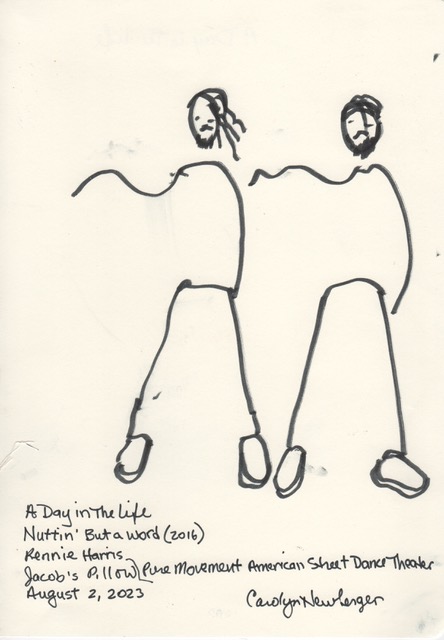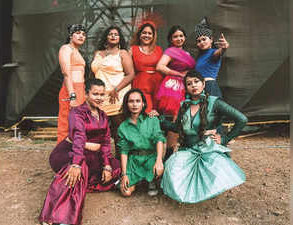Becket— As the members of the audience took their seats, two splendid musical examples of contemporary hip–hop sounded on the PA system of the Ted Shawn Theater. The African origins of the music are unmistakable, with layers of rhythm, anticipations and suspensions, and spontaneous as well as scripted – and sexualized – lyrics by a male and female singer, the latter at a slower tempo, focusing on the motions and postures of the dance: “Boogie on Down!,” which were projected on the curtain.
Pamela Tatge, Executive and Artistic Director of Jacob’s Pillow, stepped through the curtain, joined by Ali Rosa-Salas, the co-curator with Melanie George of the opening dance, D. Sabela Grimes for the Ladies of Hip-Hop Dance Collective.
Rosa-Dalas discussed the all-embracing concept of hip-hop, surveying the entire human experience with sympathy and individual identification, its music deriving principally from African-American and Puerto-Rican rhythms, and its choreographed stories that include typical positions and roles, including Lockin, Poppin, Breakin, Rockin, and b-Boying.
The evening began with a change in the program. In place of the World Premiere of Parable of Passage (2023), the first act was Thief of Hearts (2023), a parable of two burlars, choreographed and designed by Kwikstep and Rokafella, to a music mix by DJ KS360, with sampling from Carib Leap, by Ian Friday, Give it Up, Turn it Loose, by James Brown, Take Me to Mardi Gras by Crate Bug (Bob James), and Funky Soul Mokasso by Awesome Foursome.
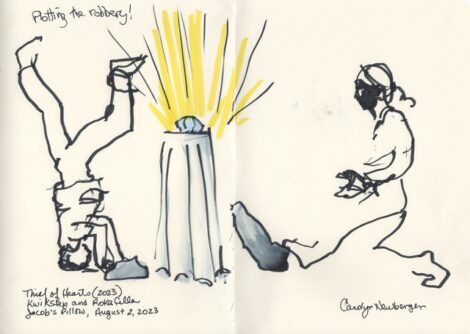
The curtain opens to a dark empty stage with a beam of brilliant light emanating from an enormous blue diamond set atop a velvet draped pedestal. Treasure! In creep two masked dancers, Kwikstep and Rokafella, of unclear genders, wearing identical black uniforms, headscarves, and backpacks. Together they consult maps and strategize in the smoky fog around the piercing light of the diamond. As they collaborate in examining the maps, they execute various hiphop moves denoting struggle, fighting one another for no apparent reason except, perhaps, their respective shares of the brilliant gem they’re planning to seize.
In startling shifts of lighting, including vivid headlamps in total darkness, flashlights, and spotlights, they gesticulate and demonstrate their athletic prowess with fluid descents, handstands, flips, and solo and duo head spins. A long solo by the heftier of the robbers was particularly impressive, with multiple headstands, prolonged spins, and displays of physical strength.
Subsequently they remove their masks, revealing this hip hop titan as Kwikstep, perhaps showing in this impressive spectacle that he is truly a man’s man! After they remove their masks, revealing one man and another figure of uncertain gender, although it becomes clear that she is a woman, a romantic undercurrent develops, with suggestions initially of homoeroticism and subsequently of male-female sexual energy.
The musical mix is fraught with tension as the climactic moment of hoisting their quarry approaches. Here, the lighting design of Mark Roxey and Julie Ballard takes magical form, when the gem in question, a diamond so big it shines into the stars, is illuminated directly and reflects upwards, sideways, and into the eyes of the burglars.
Then, the story is further complicated by Kwikstep’s stuffing the diamond into his pack, while Rokafella looks on both admiringly and balefully, as she turns her own pack upside down and nothing falls out. Disappointed, and seemingly philosophical about whether she would ultimately be compensated for her share of the crime, she leaves the stage.
The words, presumably uttered by one of the robbers, “It’s Only a Rock!” leaves unspoken the moral question, “Should Crime Pay?” And finally, the phrase “To Be Continued,” was projected on the screen as the curtains closed.
The audience cheered this affecting, beautifully danced, and conflictful scenario. Whatever stereotypes they may have had about hip-hop were shattered in this literally and figuratively dazzling performance.
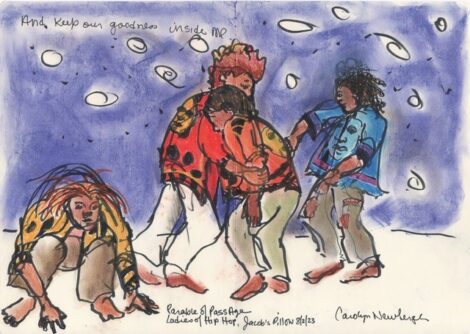
Next on the stage was the World Premiere of Parable of PassAge (2023).
This dance features four women from the Ladies of Hip Hop Dance Collective, based in Long Island City, New York.
From slender to ample, they are all beautiful, full of energy and life, and agile, exciting dancers. From the collective of the circle, to embrace, to individual improvisation, they admire each others’ looks, moves, connections, and costumes, initially Africa inspired vibrant silken shirts with images of classic Benin Bronze faces; and subsequently wraps of thick colorful rope coils hanging from collars that bounced and swayed as they danced.
According to the program notes, Parable of PassAge, commissioned by Jacob’s Pillow through the Joan B. Hunter New Work Commission, is “an extension of the larger creative Constellation, Parable of Portals, a collection of poetry, transmedia visuals, and music, intricately woven together with improvisational movement meditation.”
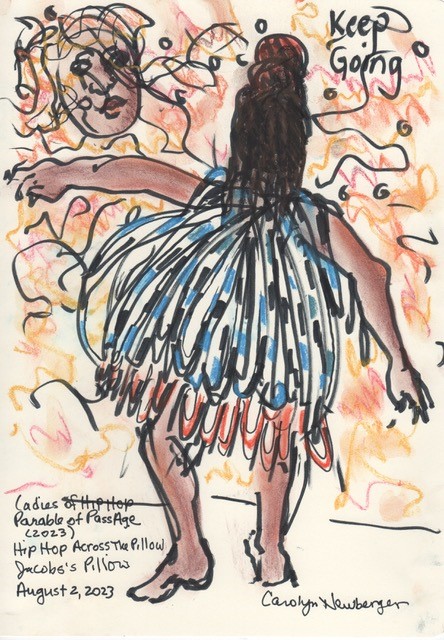
Throughout the dance, on the screen behind them, appears a montage of images, lights and shapes, of varieties of Black women’s faces, some seeming ancestral, and others modern with elegant coiffure and make-up, all surrounded by patterns that swirl and twist around them, accompanied by voice over poetry, wisdom and exhortations..
The dancing is gracious, both showy and subtle, with elegant hip hop moves, group improvisations, couplings, and supple psychological strength, expressed in such words projected on the screen and/or voiced over such as “Keep my goodness inside me,” and “I’ve been demeaned too much.”
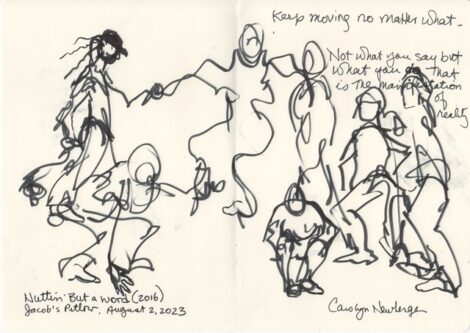
After the Intermission, Nuttin’ But a Word (2016) was reprised by choreographer Rennie Harris, the Founder and Artistic Director of Rennie Harris Pure Movement American Street Dance Theater. During the performance Harris appears on screen in several informative interviews. His mantra, he says, is “Always Keep Moving.” He considers the three laws of hip-hop to be individuality, creativity and innovation. Which means that hip-hop is fundamentally progressive and ever changing.
“To change how you view it is progressive,” he said to critic Brian Siebert of the New York Times.
The background audio for this performance featured Nina Simone’s See-Line Woman.
In the episode, A Day in the Life, the dancing, by Phillip Cuttino and Joshua Culbreath, was dynamic, punctuated by stillness, and in one deeply affecting sequence, profound grief, where the two friends were caught in a gun battle on the street. One survived, with an apparent back injury, but the other is murdered presumably by the police. The surviving friend, Culbreath, tries to lift Cuttino to his feet, but his guts pour out, covering Culbreath’s hands with blood. His cries ring out, “Please don’t leave me!” “I need you now!” “Right Now!”
Culbreath’s dance of rage and loss ensued, a miracle of athletic and emotional force, jumping up and repeatedly landing flat on his abdomen, pounding his hand practically into the floor, along with verbal exclamations of devastating loss. His was an astonishingly powerful, grief-soaked lamentation of the excruciating loss suffered by so many young Black men in America, set to the affecting music of Dahfer Youssef.
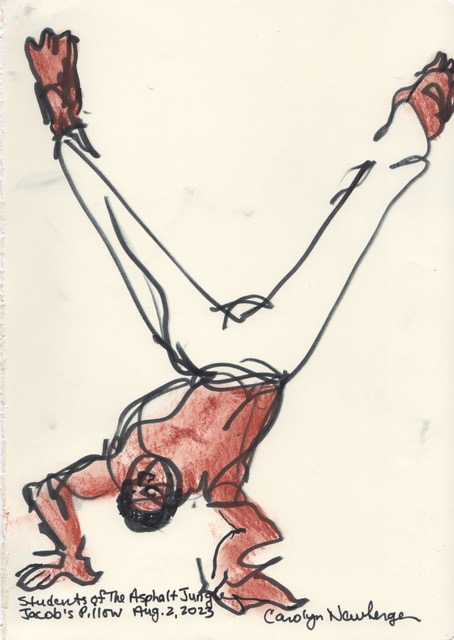
Nuttin’ But a Word ended with a rousing ensemble encyclopedia of the many forms and vocabularies of hip hop, first portrayed by an ensemble of women in black, and then by bare chested men in white pantaloons, and finally in a series of mock endings, with the curtain going up and down, and all the dancers from this splendid evening joining and jamming on the stage. This was where the audience started becoming part of the show, bouncing in their seats, clapping to the beat, and after the curtain finally, finally came down, with the music still piping in, young and old dancing in the aisles and out the exits. Hip Hop is contagious!!!!
This post was originally published on this site be sure to check out more of their content.



